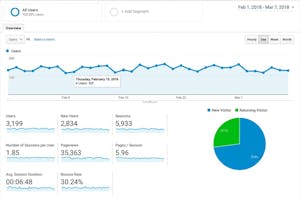- 6 minute read
- Industry Insights
- Local Strategies
All Skill Levels
Get a behind-the-scenes-look into FareHarbor's 2024 season

Our Compass digital marketing guides often highlight the importance of marketing to your target audience. Whether that’s families with kids, solo travelers, or Gen Z, understanding the ins and outs of your main customer base helps you create content, promotions, and experiences that resonate with that group – and hopefully generate repeat business.
You might have some idea of who your audience is, but doing some research and digging into the data behind your searches and conversions will help you take your marketing to the next level. Virtually every marketing asset, from paid ads to email newsletters, relies on knowing your target audience. Enhance your audience outreach and connect with future customers using the tips in this guide.
To make your content stand out in the sea of emails and social posts, you must strive to grab the attention of your target audience. This refers to the specific group of customers who are most likely to book your tours and activities, and therefore, the group of people you want to see your digital marketing efforts.
A target audience can be segmented by age, location, gender, interests, and many other factors, and often depends on the services you offer. For example, a city walking tour operator would likely have a wide audience of varying demographics, while a 21+ pub crawl would draw a more niche crowd. Either way, identifying your target audience helps you craft creative messaging that resonates with them and increases the chances of them booking a tour or activity with you.
Working on determining your target audience starts with your current customers. Take a good look at who already books your tours and activities. What are their interests? How old are they? Where do they live? If you’re not very involved in interacting with customers, ask your tour guides about the customers you typically get. You can also create customer surveys to learn more about your clientele.
 Pro Tip: Use the Contacts Report in your FareHarbor Dashboard to collect customer email addresses and contact information so you can get in touch with surveys or other audience outreach.
Pro Tip: Use the Contacts Report in your FareHarbor Dashboard to collect customer email addresses and contact information so you can get in touch with surveys or other audience outreach.
Google Analytics (GA) offers a wealth of information about your audience, specifically the people who visit your website and the behaviors they take on your site. GA gives you key insights, like what channels your target audience is coming from and which pages they’re engaging with most on your site.

The GA Audiences section lets you create reports by audience based on attributes that are meaningful to you, like age, location, and more. The metrics in the Audiences data give you excellent insights about your site users, including:
A great way to learn more about your target audience is to map their digital journey and examine how they interact with your website to make a booking. Follow the steps in this guide to identify customer personas, define goals, and list out all the touchpoints within the customer journey.
It’s easy to analyze your audience based on the customers you already have, but what about the rest of your target audience? Do market research for your industry to identify what people are searching for and who those people are.
Customer and industry trends and behavior can help you fill gaps in your marketing strategy and even the services you offer. For example, if you run food tours, and you notice that there are many searches for cocktail tours in your area, see if you can start a cocktail tour to attract new customers in your niche.
Use tools like Google Trends, Keyword Explorer, and Answer the Public to see what keywords and topics you should be targeting in your marketing materials.

Besides being a great way to connect with customers, social listening gives you so much information about your target audience and what kind of content they typically view. By paying attention to how your audience responds to and interacts with your social posts, you’ll learn what resonates with them and how to capitalize on that information.
Social platforms like Facebook and Twitter also offer analytics that show you exactly who your audience is, from their age and interests to location and hobbies.
When you have a solid understanding of who your target audience is, reevaluate your marketing strategies to create messaging that speaks to these people. You should also use the information to determine the best ways to spend your marketing budget. For example, if a particular audience is performing well, devote more of your budget to them.
Keep these strategies in mind for ads, email marketing, social media, and other marketing channels. Browse our digital marketing guides for more tips on connecting with your audience.